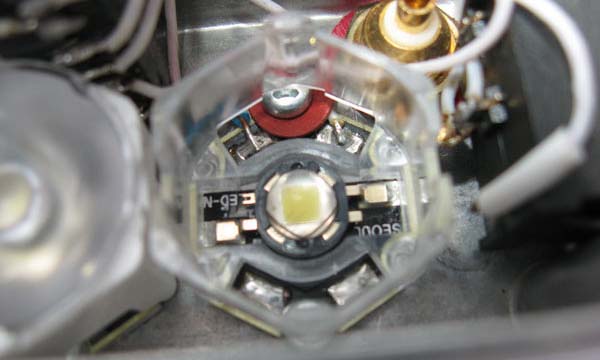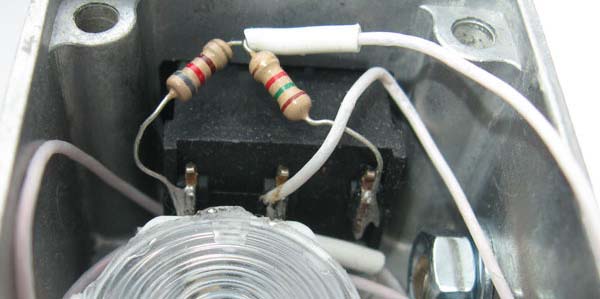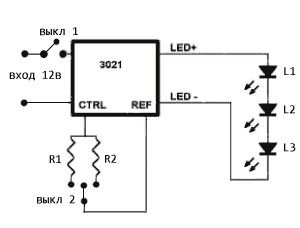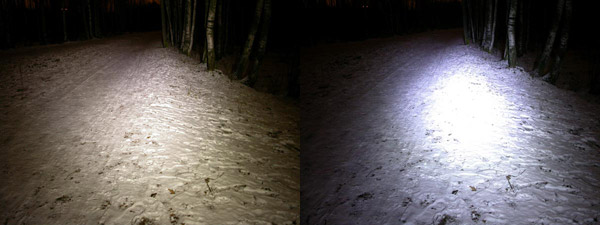The use of high-power LEDs (for example bicycle flashlight)
We all have long heard of semiconductor light sources, that is, LEDs. They are both more economical and more durable, and in general everything is very often positive. But how can this help us? LED lamps (ordinary consumer lamps with E27 and E14 caps) still cost quite a lot of money , and completely unjustified. A little better in the field of Avtosvet, there you can already order not very expensive incandescent bulbs in your car. Only while there are no particularly advantages from them, except for power consumption and sometimes reliability (because many of them are poorly assembled and do not use current stabilizers). And probably the most advanced application of high-power LEDs are flashlights and velosvet. Therefore, I will talk about the assembly of my bicycle on the basis of high-power LEDs. This experience can be applied in many areas, including to arrange LED lighting at home, with minimal soldering skills.
In addition, as far as I know, the bike is quite popular among us IT people (judging by the led forums). The fact that a normal headlight is necessary, I think it is clear to everyone who has ever ridden in the evening. And so here is a description of my experiment two years ago. By the way, in two years, in technical terms, almost nothing has changed. But the prices for bicycle lights continue to slowly fall, and the assembly of its headlights for the sake of big savings is less and less justified .
Approximate set of components for the assembly of the bicycle headlight itself. You need powerful LEDs (150r) * number of diodes + lenses and holders (100r) * number of diodes + driver in order to properly power the LEDs (200r-500r) + battery (here optional) and the case (50- ... p) + trifle like wires and connectors.
For example, from industrially produced headlights at least (high-quality headlights), you can find this: Dinotte 200L (powered by 4x AA batteries) ~ $ 90, Hope Vision 1 LED ~ $ 97. Light they give the same, the luminous flux of about ~ 200 lumens. I believe that 200 lumens is at least what you can agree on when choosing a bike. Not so long ago, a headlamp of 900 lumens appeared on a well-known site, for only $ 79. Bikers in Moscow have already conducted tests and they are impressive. If you are interested in reviews and headlight tests, you can see here , here and there .
')
But we decided to assemble the headlamp ourselves, so let's do our headlamp. By and large there is nothing supernatural or expensive in the spotlight. Therefore, to make it yourself is not at all difficult. The most difficult part is to find a comfortable case and come up with something to feed our light. Ideally, if you have access to a milling machine, it is better to make a casing like Dinotte / Hope vision 1. And it will look very decent, and an excellent radiator. But if not - also not a problem, the main thing is that the case was metal. Since high-power LEDs emit a lot of heat when working in the brightest modes, they need a decent heat sink. In more benign modes, heat dissipation is certainly less, but do not forget, overheating of the diodes decreases their resource more.
And so we begin the selection of components:
I took a simple aluminum box for REA, the type of such a simple and the whole body will be a good radiator. I drilled 6 holes for mounting the diodes and simply screwed them to the case with screws, after adding a little thermal paste between the false diode and the case. I made the grooves for the two switches and sockets for power supply.

Since I wanted to make the headlamp more powerful, I decided to put 3 LEDs, and accordingly I would need at least 12 volts to power them (3v + on the diode and margin). The body (holder) for the batteries was chosen as follows .

The diodes I chose were: P4 Seoul S42182-01LF-TST0H / Star . In this scary long title all information about the LED is written. P4 - model, Seoul - manufacturer. Next comes the bin, it is coded in it: the color temperature of the emitted light and its strength in lumens, supply voltage, color, type of lens, etc. Here is a detailed description with the decoding of all values (for diodes Seoul semiconductor).
Next were selected suitable holders for the lenses and the lenses of the company Carclo . There are no difficulties with holders, but it is better to choose whites, where they will work a little and as reflectors. Lenses for diodes differ in the angle of scattering of light, most use collimators . If you have other needs, for example, you need to scatter light as much as possible, then you can take a lens with a large scattering angle, or with a matte finish .

Powerful diodes not only makes Seoul semiconductor , but also CREE Inc. , Luxeon Philips , Edison . I chose Seoul then, because at some point it was the most effective. More than 100 lumens per watt. Now such monster Seoul p7 900lm (90lm / watt) is already available. In fact, the quad seoul p4. This is exactly what is used in the super bright Chinese spotlight with a Dealextreme. You can choose the most convenient or affordable - the choice is large.
And so back to the diodes. These diodes give the so-called natural white light. That is, it is close to the white light. Due to the fact that while there is no source of white light, it turns out with the help of phosphor. And the more white light we need, the lower the luminous flux will be (because in reality such diodes emit blue light). Therefore, in almost all industrial headlamps use pure white LEDs (they have more lumens), which give a bluish light (in the manner of xenon). In the descriptions of the diodes you can find graphs of the emitted spectrum. Here is a compilation of various modifications of white diodes Seoul P4 compiled by me:

As you can see, natural white emits more light in the range that is most susceptible to our eyes. In addition, naturally, white light is better than blue, firstly, on wet asphalt and the ground it’s seen much better, and secondly, it’s just nicer.
Since at that time I already had two Dinotte 200L, and in them it was pure white diodes, I decided to make a headlamp with normal white light, having sacrificed a little luminous flux in advance. And more about diodes, it is easier to use diodes performed by star, and not emitter. Their substrate does not conduct current, and we can safely fix all the diodes on one radiator. Yes, and attach the lens to them easier.
Here are the star and emitter diodes:

Diodes can be ordered both on Dealextreme.com or his twin brother Kaidomain.com , and in a lot of small local firms selling LED components (two years ago I ordered everything on planar.spb.ru , now there are much more such firms).

And so we figured out the diodes, now let's figure out how to properly power them. In order to properly power the diodes, we need a stabilized current, and the driver will help us in this. Firstly, without this, we will not get its calculated power and service life will be less, secondly, the drivers, which are smarter, allow us to choose power sources over a wide range, and at the same time to regulate the output current. All decent headlights feed the diode (s) through the driver. If you are able to assemble a current stabilization scheme yourself, then the price of the device will be greatly reduced. We will go in the simple way, we will take the ready driver who will make everything for us. You can order it in the same place as the diodes, Dealextreme / Kaidomain /, etc. I then chose the most advanced driver at that time (albeit the most expensive) LUXDRIVE Buckpack 3021-DI-1000 .
This driver accepts up to 32 volts at the input, produces adjustable current up to 1A, has an input for connecting a variable resistor (to change the output current and, accordingly, the brightness of the connected diodes) and is extremely easy to use. Drivers are available for both AC and 220V mains - for all occasions. So you can use LED light anywhere now, including making light in an apartment for example. If you feed the diodes from the battery or batteries, do not forget about a small margin, so that the input receives 2-3 volts more than you want to get at the output.
The final scheme of the headlights:

Where is the layout in the case:

A few words about the connection of diodes, it is better to connect in series, since the diodes still have slightly different characteristics and, if connected in parallel, unpleasant nuances in operation are possible.
Here is a comparison with two Dinotte 200L ~ 400 lumens headlamps and this homemade ~ 500 lumens headlamp. On the left, this homemade headlight (natural white diodes), lenses with an angle of 15 degrees, on the right 2 x Dinotte 200L (pure white diodes), lenses with an angle of 7 degrees. The white balance in the camera is fixed.

That's almost all that can be said about the use of high-power diodes. It's really simple, even a beginner can assemble a circuit with a ready-made driver; literally, you need to connect the diodes with a wiring — a driver — a power source. Now the number of ready-made solutions (modules) can already satisfy almost all needs. For example, the acriche series from Seoul semiconductor is connected directly to the 220v network. There are also many solutions from other manufacturers.
If something is not clearly written - ask, I will try to answer and explain. The article was a long one, so mistakes are inevitable (I certainly checked a couple of times), write in a personal message if something goes wrong.
In addition, as far as I know, the bike is quite popular among us IT people (judging by the led forums). The fact that a normal headlight is necessary, I think it is clear to everyone who has ever ridden in the evening. And so here is a description of my experiment two years ago. By the way, in two years, in technical terms, almost nothing has changed. But the prices for bicycle lights continue to slowly fall, and the assembly of its headlights for the sake of big savings is less and less justified .
Approximate set of components for the assembly of the bicycle headlight itself. You need powerful LEDs (150r) * number of diodes + lenses and holders (100r) * number of diodes + driver in order to properly power the LEDs (200r-500r) + battery (here optional) and the case (50- ... p) + trifle like wires and connectors.
For example, from industrially produced headlights at least (high-quality headlights), you can find this: Dinotte 200L (powered by 4x AA batteries) ~ $ 90, Hope Vision 1 LED ~ $ 97. Light they give the same, the luminous flux of about ~ 200 lumens. I believe that 200 lumens is at least what you can agree on when choosing a bike. Not so long ago, a headlamp of 900 lumens appeared on a well-known site, for only $ 79. Bikers in Moscow have already conducted tests and they are impressive. If you are interested in reviews and headlight tests, you can see here , here and there .
')
But we decided to assemble the headlamp ourselves, so let's do our headlamp. By and large there is nothing supernatural or expensive in the spotlight. Therefore, to make it yourself is not at all difficult. The most difficult part is to find a comfortable case and come up with something to feed our light. Ideally, if you have access to a milling machine, it is better to make a casing like Dinotte / Hope vision 1. And it will look very decent, and an excellent radiator. But if not - also not a problem, the main thing is that the case was metal. Since high-power LEDs emit a lot of heat when working in the brightest modes, they need a decent heat sink. In more benign modes, heat dissipation is certainly less, but do not forget, overheating of the diodes decreases their resource more.
And so we begin the selection of components:
I took a simple aluminum box for REA, the type of such a simple and the whole body will be a good radiator. I drilled 6 holes for mounting the diodes and simply screwed them to the case with screws, after adding a little thermal paste between the false diode and the case. I made the grooves for the two switches and sockets for power supply.

Since I wanted to make the headlamp more powerful, I decided to put 3 LEDs, and accordingly I would need at least 12 volts to power them (3v + on the diode and margin). The body (holder) for the batteries was chosen as follows .

The diodes I chose were: P4 Seoul S42182-01LF-TST0H / Star . In this scary long title all information about the LED is written. P4 - model, Seoul - manufacturer. Next comes the bin, it is coded in it: the color temperature of the emitted light and its strength in lumens, supply voltage, color, type of lens, etc. Here is a detailed description with the decoding of all values (for diodes Seoul semiconductor).
Next were selected suitable holders for the lenses and the lenses of the company Carclo . There are no difficulties with holders, but it is better to choose whites, where they will work a little and as reflectors. Lenses for diodes differ in the angle of scattering of light, most use collimators . If you have other needs, for example, you need to scatter light as much as possible, then you can take a lens with a large scattering angle, or with a matte finish .

Powerful diodes not only makes Seoul semiconductor , but also CREE Inc. , Luxeon Philips , Edison . I chose Seoul then, because at some point it was the most effective. More than 100 lumens per watt. Now such monster Seoul p7 900lm (90lm / watt) is already available. In fact, the quad seoul p4. This is exactly what is used in the super bright Chinese spotlight with a Dealextreme. You can choose the most convenient or affordable - the choice is large.
And so back to the diodes. These diodes give the so-called natural white light. That is, it is close to the white light. Due to the fact that while there is no source of white light, it turns out with the help of phosphor. And the more white light we need, the lower the luminous flux will be (because in reality such diodes emit blue light). Therefore, in almost all industrial headlamps use pure white LEDs (they have more lumens), which give a bluish light (in the manner of xenon). In the descriptions of the diodes you can find graphs of the emitted spectrum. Here is a compilation of various modifications of white diodes Seoul P4 compiled by me:

As you can see, natural white emits more light in the range that is most susceptible to our eyes. In addition, naturally, white light is better than blue, firstly, on wet asphalt and the ground it’s seen much better, and secondly, it’s just nicer.
Since at that time I already had two Dinotte 200L, and in them it was pure white diodes, I decided to make a headlamp with normal white light, having sacrificed a little luminous flux in advance. And more about diodes, it is easier to use diodes performed by star, and not emitter. Their substrate does not conduct current, and we can safely fix all the diodes on one radiator. Yes, and attach the lens to them easier.
Here are the star and emitter diodes:

Diodes can be ordered both on Dealextreme.com or his twin brother Kaidomain.com , and in a lot of small local firms selling LED components (two years ago I ordered everything on planar.spb.ru , now there are much more such firms).

And so we figured out the diodes, now let's figure out how to properly power them. In order to properly power the diodes, we need a stabilized current, and the driver will help us in this. Firstly, without this, we will not get its calculated power and service life will be less, secondly, the drivers, which are smarter, allow us to choose power sources over a wide range, and at the same time to regulate the output current. All decent headlights feed the diode (s) through the driver. If you are able to assemble a current stabilization scheme yourself, then the price of the device will be greatly reduced. We will go in the simple way, we will take the ready driver who will make everything for us. You can order it in the same place as the diodes, Dealextreme / Kaidomain /, etc. I then chose the most advanced driver at that time (albeit the most expensive) LUXDRIVE Buckpack 3021-DI-1000 .
This driver accepts up to 32 volts at the input, produces adjustable current up to 1A, has an input for connecting a variable resistor (to change the output current and, accordingly, the brightness of the connected diodes) and is extremely easy to use. Drivers are available for both AC and 220V mains - for all occasions. So you can use LED light anywhere now, including making light in an apartment for example. If you feed the diodes from the battery or batteries, do not forget about a small margin, so that the input receives 2-3 volts more than you want to get at the output.
The final scheme of the headlights:

Where is the layout in the case:

A few words about the connection of diodes, it is better to connect in series, since the diodes still have slightly different characteristics and, if connected in parallel, unpleasant nuances in operation are possible.
Here is a comparison with two Dinotte 200L ~ 400 lumens headlamps and this homemade ~ 500 lumens headlamp. On the left, this homemade headlight (natural white diodes), lenses with an angle of 15 degrees, on the right 2 x Dinotte 200L (pure white diodes), lenses with an angle of 7 degrees. The white balance in the camera is fixed.

That's almost all that can be said about the use of high-power diodes. It's really simple, even a beginner can assemble a circuit with a ready-made driver; literally, you need to connect the diodes with a wiring — a driver — a power source. Now the number of ready-made solutions (modules) can already satisfy almost all needs. For example, the acriche series from Seoul semiconductor is connected directly to the 220v network. There are also many solutions from other manufacturers.
If something is not clearly written - ask, I will try to answer and explain. The article was a long one, so mistakes are inevitable (I certainly checked a couple of times), write in a personal message if something goes wrong.
Source: https://habr.com/ru/post/89136/
All Articles